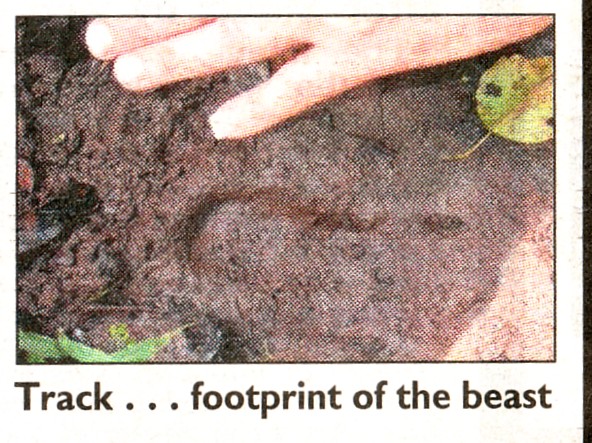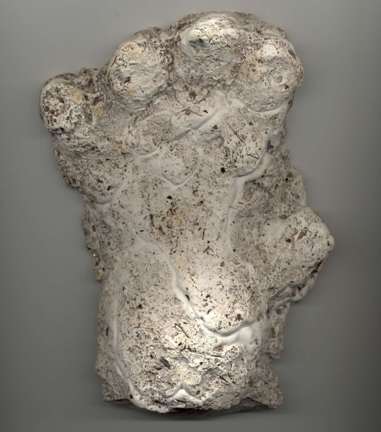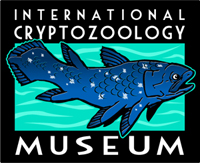Davies Addresses Cryptomundo Questions
Posted by: Loren Coleman on October 2nd, 2009

Adam Davies (above), expedition leader of the Orang Pendek trek, and author of Extreme Expeditions, responses, via his journal on Friday, October 2, 2009, directly to people here.
He writes, in part (edited for typos):
I should answer a few of the points raised by people in Cryptomundo and elsewhere. So here are a few that really struck me:
1/ Firstly, I am not a member of the CFZ. That said, I have always supported their aims, and the other three members of the expedition team are members. I led the expedition, and invited those people on the team because I though they had unique skills to offer, not because of any organisation they belonged to. Dave is a great Tracker, Chris a level headed explorer with considerable technical expertise, and Richard because of his considerable zoological expertise. We paid for the expedition as private individuals; we were not funded by any organisation including the CFZ, and any equipment we brought was our own. I am not under contract with any film company, and the press releases issued by the CFZ have nothing to do with me. I do not see them before they go out.
2/ In terms of planning, I have been to Sumatra some 5 times. The area I picked to go this time was very carefully chosen by me, as I have found footprints and/or hair samples before. The analysis is done by independent scientists, not cryptozoologists. For example, the hairs were previously studied by Dr. Hans Brunner, famous for his scrutiny in the Lindy Chamberlain murder trial. The prints have been analysed by Dr. Jeff Meldrum (U.S.A) and by David Chivers from the University of Cambridge. They independently came to the decision that they were from an unkown primate. Professor Todd Disotell will be carrying out the analysis this time.
3/ Equipment is always an emotive subject. There is always something better you could bring, but as I have said, we brought the best we had with the money we had. That included night vision equipment, infared cameras, and camera traps. Do not forget, you have to haul all this gear through the jungle, and weight is a serious issue. If I get better equipment I will use it. Witness the films I have made for the History Channel. My only regret in terms of equipment is that the plaster of Paris the guides had purchased for casting, had degraded and we could not use it….I have got a print there before, which has been shown on Cryptomundo, and we found several trails, these were photographed to scale. These things happen in the field .
4/ Matt Billie asked a very good question as to whether it could have been a Lars Gibbon. I am used to seeing Gibbons in the jungle, and Sahar is a really experienced guide. I am certain he would not mistake an Orang-Pendek for a Gibbon, and his astonished reaction compounds that view. The physical descriptions by both eyewitnesses do not match Gibbon.
5/ Normally my expeditions do not last more than a month or less, because I have to work full time. In my dream scenario I make films, and do this full time. Unfortunately, I am not yet living the dream, so back to the day job.
I will be sending off the samples on Saturday. I will update this blog again later next week.
Adam Davies
Please click on the image for a larger version of the photograph.
Above is the Adam Davies-Andrew Sanderson-obtained Orang Pendek field cast, from September 2001. The original was displayed as part of the Bates College cryptozoology exhibition in 2006, held in conjunction with the International Cryptozoology Museum. A first generation copy of this cast will be shown in the new public location of the museum.
Join others in the community in supporting the International Cryptozoology Museum as it opens in downtown Portland, Maine.
Please click on the button below (not the one up top) to take you to PayPal to send in your museum donation.
If you wish to send in your donation via the mails, by way of an international money order or, for the USA, via a check (made out to “International Cryptozoology Museum”) or money order, please use this snail mail address:
Loren Coleman, Director
International Cryptozoology Museum
PO Box 360
Portland, ME 04112
Thank you, and come visit the museum at 661 Congress Street, Portland, Maine 04101, beginning November 1, 2009!!
About Loren Coleman
Loren Coleman is one of the world’s leading cryptozoologists, some say “the” leading living cryptozoologist. Certainly, he is acknowledged as the current living American researcher and writer who has most popularized cryptozoology in the late 20th and early 21st centuries.
Starting his fieldwork and investigations in 1960, after traveling and trekking extensively in pursuit of cryptozoological mysteries, Coleman began writing to share his experiences in 1969. An honorary member of Ivan T. Sanderson’s Society for the Investigation of the Unexplained in the 1970s, Coleman has been bestowed with similar honorary memberships of the North Idaho College Cryptozoology Club in 1983, and in subsequent years, that of the British Columbia Scientific Cryptozoology Club, CryptoSafari International, and other international organizations. He was also a Life Member and Benefactor of the International Society of Cryptozoology (now-defunct).
Loren Coleman’s daily blog, as a member of the Cryptomundo Team, served as an ongoing avenue of communication for the ever-growing body of cryptozoo news from 2005 through 2013. He returned as an infrequent contributor beginning Halloween week of 2015.
Coleman is the founder in 2003, and current director of the International Cryptozoology Museum in Portland, Maine.













DWA- Well, I don’t know if I can agree with the statement that an animal being known to exist is irrelevant. With a mink, if someone doesn’t see it, we can be sure that this is because they in fact just haven’t seen one.
This is a bit more difficult with something like the Orang Pendek. Whereas with a mink, you can sit down and show someone indisputable proof that it does indeed exist despite the lack of seeing one, whereas with cryptids all you can do is show the evidence up to now and then they are in the same position as us, trying to make sense of it. They may deny what you show them, but we are in no position to say that they are definitely wrong. We can do that with the mink. This is why I think it is perfectly reasonable to say “but we know the mink exists.” It’s existence is not in dispute. The Orang Pendek’s is.
Of course if the Orang Pendek exists, then they do so without needing scientific confirmation. But if that is your stance, then you have to say the same thing applies to fairies, ghosts, and interdimensional orbs (things that many people believe to be real). But consider how do we know what is real and what is not? The key word here is if they exist. Until we can be sure, then I for one am not going to assume the Orang Pendek must be real and we just haven’t found it yet. I will look at the evidence, but it is an unknown at this point, at least from the view of mainstream science. Until it goes from if it exists, to it does exist, we just don’t know and as such can not make too many assumptions. All we can do is take a look at what evidence turns up. We can’t compare that to an animal that we know is real and is well documented (like the mink).
Science doesn’t make something real just by confirming it, but does help to parse out what is real from what is not.
Many cryptids might exist, and in many cases seem like they likely do, but we have to be sure. Science does not go around assuming something is real until is is shown not to be. We need to find out what is really going on through careful means, to go from if to is beyond a reasonable doubt. That is what Davies is out there trying to do.
The mink has passed this threshhold, the Orang Pendek has not. If it had, it would no longer be a cryptid. That doesn’t mean I think it doesn’t exist, in fact I think it is quite plausible, but we don’t know yet. Well, at least I don’t. I am not completely convinced at this point.
As far as “local skeptics” go, I’ll use an example from another animal. I’m not trying to get off topic, bear with me. In Japan we have a very rare wildcat known as the Iriomote cat, from the tiny island of Iriomote. It is documented to exist, this is not in dispute at all. Yet many locals who have lived on the island have never seen one, and among these, many actually deny that it is a real animal, or that it is merely stray cats.
The thing is, like with the mink, we can sit them down and show them that it does indeed exist and that they just haven’t seen one. With the Orang Pendek, that might be the reason locals haven’t seen one, or it might mean there is nothing there to see. We just don’t know.
That being said, the Iriomote cat wasn’t documented until the 60s, and was well known to some locals before that. So of course we should seriously consider what the locals say about the Orang Pendek. But until we know for sure, it is no mink or Iriomote cat just yet. We cannot be assured of its reality.
I think cryptozoology is trying to find out about these things to the best of our knowledge, and it is not helpful to treat these cryptids as givens that exist “whether we want them to or not.” Time and evidence will be the judge of that.
Maybe I’ve misunderstood what you were saying, but I don’t think we can compare unknowns to knowns and treat them as the same thing.
DWA- And yes, I still think that the Orang Pendek search should continue. I don’t mean to detract from that. It is actually one cryptid that I am fairly excited about concerning the possibilities. I just think that like any research, it should be conducted carefully and without too many assumptions. It remains an unknown as far as science is concerned. Maybe to some locals it is quite real, and perhaps it is, but we just don’t know.
I’m not laughing at those who search for the Orang Pendek. In fact, I commend them. If they turn up something solid, it will be a great help to zoology.
Until we can be sure, though, I just don’t think that the mink is a good analogy here. I hope you realize that I am certainly not jumping down your throat. I may have even misunderstood your angle there. I was just trying to explain my thoughts on that statement.
Or maybe I just need a decaf. 😉
mystery_man:
“Well, I don’t know if I can agree with the statement that an animal being known to exist is irrelevant. ”
Oh, I didn’t say it was irrelevant. I said that it’s a logical fallacy to consider stuff like, say, guys in suits to be evidence against an animal, because if the animal’s real, then the guys in suits ARE irrelevant. (And most of the sightings – all of them, in fact, of the orang pendek – don’t have anything to do with fakery, and they don’t appear to reflect lying either.)
If my statement that I haven’t seen a mink doesn’t serve as evidence that the mink isn’t real, people not having seen an orang pendek can’t count as evidence against it, either, because if it’s real, then the lack of sightings obviously happened for other reasons.
My point comes down to this. The evidence for the existence of an animal can only be countered by debunking, i.e., showing that that evidence is in fact evidence of something else. If the evidence for is unchallenged, then it stands. Not as proof, but as a hint that maybe we haven’t looked enough yet.